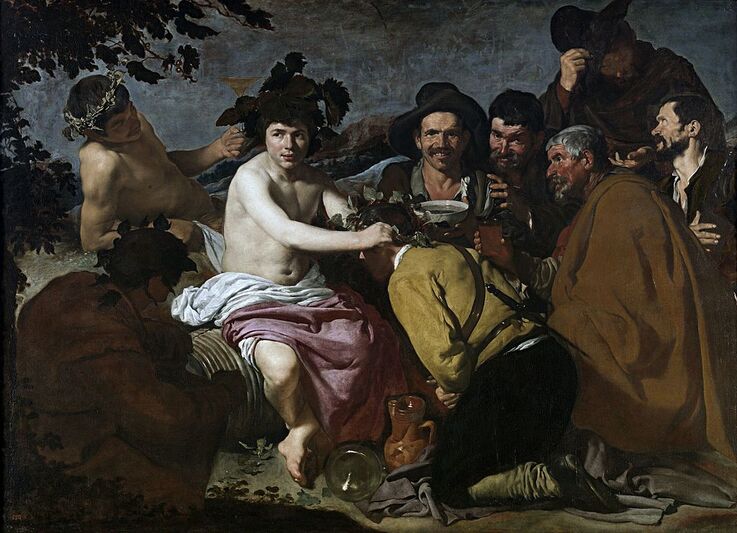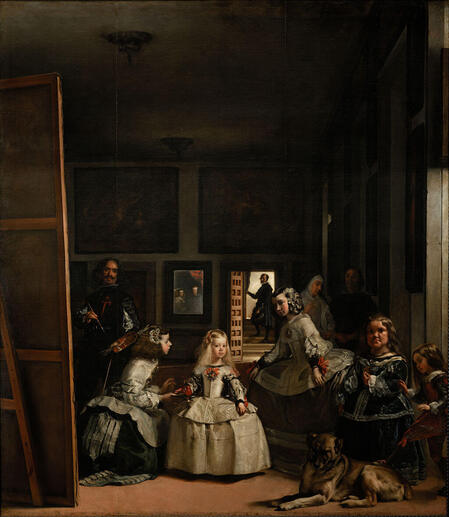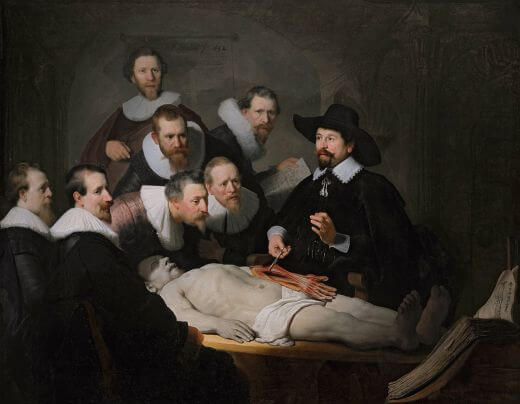|
Where? Room 11 of the Prado Museum
When? 1628-1629 Commissioned by? Velázquez created this painting for King Philip IV of Spain and Portugal and received 100 silver ducats for it. What do you see? The bare-chested man with the pale body is Bacchus. He sits on a wine barrel and is crowned with a wreath of vine leaves. At his feet are two jugs. Bacchus is surrounded by peasants wearing 17th-century Spanish clothes. To his right, he welcomes the kneeling soldier wearing a sword by putting a wreath of vine leaves on his head. Meanwhile, Bacchus looks in the other direction. Some of the other people have raised their glasses to welcome the new man. The man with the hat, directly to the right of Bacchus, is holding a big bowl of wine and stares directly at us while laughing. The men to his right, with the hand on his shoulder, is clearly drunk. The kneeling man in the brown cloak in the right foreground raises his glass in honor of Bacchus. The man on the complete right welcomes a passerby taking off his hat to greet the group of people. To the left of Bacchus is a nude satyr (a male companion of Bacchus with horse ears and a permanently erect penis) with a wreath of vine leaves. The satyr holds a full martini glass. The final person sits in the left foreground and also wears a wreath of vine leaves. He is painted in the shadow, probably to enhance the contrast with the pale Bacchus. Velázquez did not put much effort into the background of the painting, which may be because he originally painted this work inside, probably in a tavern. Backstory: This painting is known under various names, depending on what people think the focus of this painting is (and it is also not entirely clear what the motivation of Velázquez for this painting was). The most conventional name is ‘The Triumph of Bacchus’ which refers to Bacchus bringing the gift of wine to the common people to relieve them from their daily concerns. The painting is also known as ‘The Drunkards’ (or ‘Los Borrachos’ in Spanish) which refers to the intoxicated people in this painting. Velázquez created this painting during the time that Peter Paul Rubens, the most famous painter of that time, visited Madrid for nine months. During that time, Velázquez could observe the work and the technique of Rubens. Velázquez realized that he could not compete with Rubens by trying to copy his style and so he kept his own style to remain unique. This painting is also the first time that he included some nudity in his work, something that Rubens did more frequently, such as in Rubens’ Samson and Delilah in the National Gallery in London.
Who is Bacchus? Also known in Greek mythology as Dionysus, Bacchus is the god of wine, winemaking, fertility, and theatre. He is closest to the common people among the mythological gods and is, therefore, a popular subject among artists. He stands for freedom, drinking, and dancing, which has been attractive to many people over the centuries.
Many artists have used Bacchus as a subject of their art. For example, in 1595, Caravaggio painted Bacchus in the Uffizi Museum, and, in 1522-1523, Titian painted Bacchus and Ariadne in the National Gallery in London.
Who is Velázquez? Diego Rodríguez de Silva y Velázquez was born in 1599 in Seville and died in 1660 in Madrid, Spain. He became the lead court painter for King Philip IV during his twenties. Besides many painting portraits of well-known people including the Spanish royal family, he created mainly historical paintings. His works did not become very popular outside Spain until the 19th century.
Velázquez has had a big influence on future painters such as Manet, Picasso, and Dali. Over his career, Velázquez constantly improved his painting style, which became more refined and realistic. This ultimately resulted in 1656 in the creation of his best work, Las Meninas, which is also on view in the Prado.
Fun fact: It is interesting to compare this painting to another masterpiece from the same time period. In 1632, Rembrandt painted The Anatomy Lesson of Dr. Nicolaes Tulp which is now in the Mauritshuis in The Hague, The Netherlands. Velázquez was about 29 years old when he painted The Triumph of Bacchus and Rembrandt was 26 years old when he painted about the anatomy lesson. The two had never met each other.
Both Velázquez and Rembrandt depicted nine different people and some nudity. The main difference is that the people in Rembrandt’s work are quite static while the people in Velázquez’s work are showing more emotion and feel more real. Both are considered masterpieces nowadays and you can decide for yourself which painting you prefer.
0 Comments
|
Categories
All
|
- Home
- Blog
-
Museums
- Alte Pinakothek
- Art Institute of Chicago
- Baltimore Museum of Art
- Barber Institute of Fine Arts
- Bargello
- Barnes Foundation
- British Museum
- Church of Sant’Anastasia
- Cleveland Museum of Art
- Courtauld Institute of Art
- Detroit Institute of Arts
- Frans Hals Museum
- Galleria Borghese
- Gallerie dell'Accademia
- Getty Museum
- Guggenheim
- Hermitage Museum
- Kunsthistorisches Museum
- Kunstmuseum Basel
- Legion of Honor Museum
- Louvre
- Mauritshuis
- Metropolitan Museum of Art
- Musee d’Orsay
- Museum of Fine Arts in Boston
- Museum of Modern Art
- National Gallery in London
- National Gallery of Art
- National Museum in Poznań
- Norton Simon Museum
- Ny Carlsberg Glyptotek
- Palace of Versailles
- Palazzo Pitti
- Palazzo Vecchio
- Petit Palais
- Philadelphia Museum of Art
- Prado
- Pushkin Museum
- Ravenna Art Museum
- Rijksmuseum
- San Diego Museum of Art
- Santa Maria delle Grazie
- St. Peter's Basilica
- Städel Museum
- Statens Museum for Kunst
- Tate Britain
- Tate Modern
- Timken Museum of Art
- Uffizi
- Vatican Museums
- Wallace Collection
-
Artists
- Altdorfer
- Anguissola
- Berlin Painter
- Bosch
- Botticelli
- Boucher
- Bronzino
- Bruegel the Elder
- Brunelleschi
- Cabanel
- Caillebotte
- Canova
- Caravaggio
- Carpeaux
- Cezanne
- Cimabue
- David
- Degas
- Delacroix
- De Maria
- Donatello
- El Greco
- Fontana
- Fra Angelico
- Fragonard
- Gauguin
- Gentileschi
- Gericault
- Gonzalez-Torres
- Goya
- Hals
- Hogarth
- Hokusai
- Ingres
- Leonardo da Vinci
- Lippi, Filippo
- Longhi, Barbara
- Lorrain
- Makovsky
- Manet
- Massys
- Matisse
- Merian
- Michelangelo
- Mochi
- Modigliani
- Monet
- Panini
- Parmigianino
- Perugino
- Picasso
- Pisanello
- Raphael
- Rembrandt
- Renoir
- Reynolds
- Rivera
- Rodin
- Rubens
- Scultori
- Seurat
- Steen
- Tintoretto
- Titian
- Toulouse-Lautrec
- Turner
- Uccello
- Van der Weyden
- Van Dyck
- Van Eyck
- Van Gogh
- Van Hemessen
- Vasari
- Velazquez
- Vermeer
- Veronese
- Vigée Le Brun
-
Locations
- Books
- About Us






